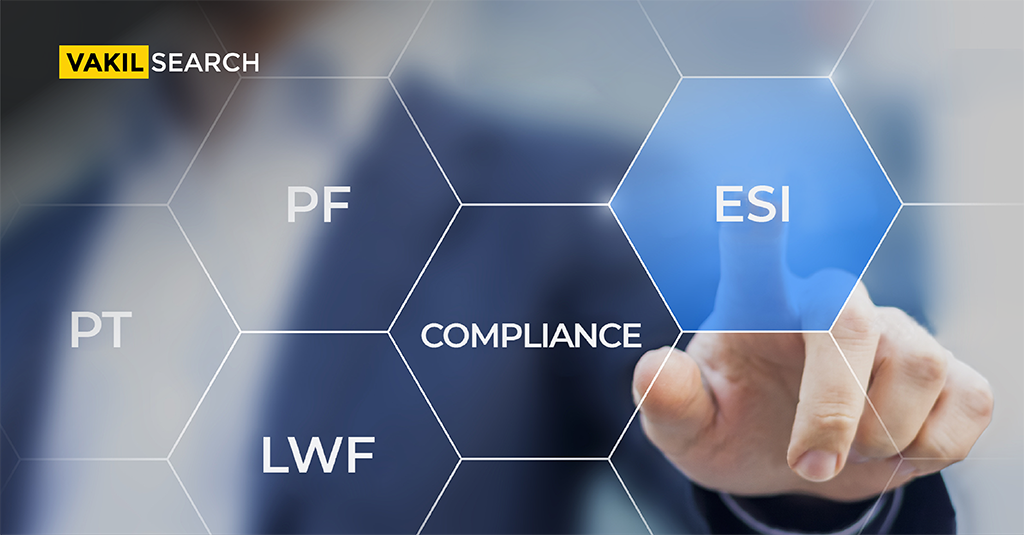The Employees’ State Insurance is one of the world’s largest social security schemes that provide benefits to millions of people across India. All eligible private companies registered in India have to enroll under this scheme, as per the Employee State Insurance Act, 1948.
The Employees’ State Insurance program is one of the popular social security schemes brought into force by the central government after India’s independence. All eligible companies have to register under the ESI Act, 1948. Failure to enrol under the ESI regime can make such companies liable to face legal actions. As a result, companies need to ensure they adhere to the provisions of the ESI Act to stay on the right side of the law.
What is Employees’ State Insurance?
Employees’ State Insurance is a self-financing social security scheme and health insurance plan for Indian workers that offers medical and disability benefits. Governed by the ESI Act, 1948, it is managed by the Employees’ State Insurance Corporation (ESIC) under the Ministry of Labour and Employment. The ESIC manages the funds collected as per the rules and regulations laid down by the ESI Act.
When is ESI Registration Mandatory?
ESI registration is mandatory if a company or entity employs ten or more low-earning employees. According to the ESI Act, any employee earning less than ₹15,000 a month must contribute 1.75% of their pay towards the ESI. The company or employer must contribute the remaining 4.75% towards their ESI. The ESI scheme provides tremendous benefits to employees and works as India’s primary social security scheme. The system has a large network of dispensaries, and hospitals throughout India to facilitate fast and efficient medical care.
All establishments, entities, units, and factories that employ over ten people who earn less than ₹15,000 a month must be wary of the ESI Act. As per Indian law, such entities must mandatorily apply for ESI registration within 15 days of the Act becoming applicable to them. Vakilsearch specializes in helping companies complete their ESI Registration.
What are the Documents Required for ESI Registration?
The following documents are required for registering under the ESI scheme:
- Registration certificate or a license obtained under the shop and establishment act license or Factories Act
- Memorandum or Articles of Association for private limited companies, partnership deeds for LLPs, or Trust deeds, depending on the type of entity
- Certificate of registration for all entities and commencement of production for factories
- A list of employees with their monthly compensation, in detail
- A list of directors, partners, and shareholders of the company
- PAN card of the business and address proof of the establishment
- Bank statements of the organization, with evidence of the commencement of operation
What Is the ESI Registration Procedure?
The applicants have to first ensure they have all the documents required for completing the registration. To prevent delays in processing, business owners must collect all the required documents before starting the registration process. The registration procedure requires business owners to apply for enrolment online by submitting Form-1. Businesses must download a copy of the form in PDF format from the government’s official website and submit it after duly filling it out. Since the form contains several sections, it is advisable to take the help of professionals when registering your company for ESI. The applicants need to be careful while filling the form and uploading the required supporting documents. Any errors made can be costly and difficult to update later on, and hence, companies need to double-check everything before submitting.
While the registration is permanent, companies and business owners must make changes, as and when employee additions occur so as to stay updated. Vakilsearch helps businesses complete their ESI registration with ease by handling the whole process digitally. After completing your registration, Vakilsearch will notify you of your organisation’s 17-digit unique identification number to complete your filings. Additionally, we also offer packages that include filing your ESI returns for you, to ensure your company always stays on the right side of the law.
Filing of ESI Returns
Companies need to file ESI returns on a half-yearly basis. However, before starting the procedure for filing the ESI returns, all eligible corporate entities with more than ten employees must register under the ESI scheme. Companies must use their 17-digit unique ID to file their half-yearly returns. Employees, upon registration, receive an ESI card that contains details of their family members and employer. Companies can file their ESI returns online through the government’s official portal for the same.
What Are the Documents Required to File ESI Returns?
Companies must maintain the following documents regularly for filing ESI returns.
- Attendance register
- Register for Form 6
- Register of wages
- Inspection book
- Register of any accidents on the premises
- Monthly challans and returns submitted for ESI
How to File Your ESI Returns Online
Employers can also verify details regarding their returns and contributions by using the information tab on the government’s website: https://www.esic.in/EmployerPortal/ESICInsurancePortal/Portallogin.aspx. Companies will have to deduct a part of the salary they provide employees towards the ESI fund. Additionally, a significant part of the ESI deposits will come from the company, and these contributions must be made regularly by the employer. Companies need to use login credentials provided by the ESIC office to log into the portal to file their returns on time. The portal also allows employers to take various actions, including adding or editing employee details and reporting accidents.
Employers should use this portal to maintain records regarding their monthly contributions and update their employee details. Since this process can be quite lengthy and complicated to handle every month, Vakilsearch helps businesses process their ESI returns smoothly. Our legal experts will manage your ESI contribution and file all the required returns to ensure smooth operation, without any hiccups.
Frequently Asked Questions
1. What is the procedure for the registration of an employer?
An employer must Form-1 within 15 days of the ESI Act becoming applicable to their establishment or unit.
2. Is it mandatory for employers to register under the ESI?
Yes, it is mandatory for all eligible employers to register their unit/factory/establishment. Hence, it is the legal responsibility of the employer to register their unit/factory/ establishment under the ESI Act within 15 days of the Act becoming applicable to them.
3. What are the compliance requirements under the ESI Act?
Every employer who is covered under this Act must comply with various guidelines. These rules specify how to deposit monthly contributions, file half-yearly returns and report to authorities in case of any changes in the business activity, address, ownership or management of the business. Additionally, registered businesses must also follow compliance requirements regarding the maintenance of registers and records.
4. Are the benefits granted to the insured employees transferable?
No, the right to receive any benefits under this Act is not transferable.
5. What is the ESI Code number?
The ESI Code number is a 17-digit unique identification number allotted to every registered establishment. This number gets generated through the ESIC portal when the employer submits all the required information. It may also be generated on receipt of a survey report from the Social Security Officer.
6. Is it possible for an establishment once covered to cancel their registration if the number of persons employed falls below the minimum limit prescribed?
Once a factory or establishment gets covered under the Act, it will continue to be covered even if the number of employees falls below the minimum required limit at any time or if there is any change in the manufacturing activity.
7. If the wages of an employee exceeds ₹15,000/- in a month, won’t they be covered anymore?
If an employee’s wages, excluding the remuneration for overtime, exceeds the wage limit prescribed by the Central Government, they will continue to be an employee till the end of that contribution period. Therefore, their contribution must be deducted and paid on the total wages earned by him.
8. Is the overtime done by the employee to be included in the wage ceiling limit for coverage?
No, the overtime done by the employee is not included for calculating the wage ceiling limit for coverage. But, it is included for the payment of the contribution to cover the risk during the period of overtime work and to enable receiving the cash benefits at an enhanced rate.
9. What is the time limit for the payment of the contribution?
The contribution must be paid into a bank duly authorised by the company within 21 days of the last day of the month in which the contribution is due for any wage period.
10. What is the mode of payment of the contributions?
The employer must file a monthly contribution online through the ESIC portal, and the to be paid is calculated regularly. Additional details to be provided include the number of days employed, wage amount and payable contribution. The total amount of contribution for each month must be deposited in any SBI branch in cash, cheque or demand draft on a generation of such a challan through the ESIC portals. The contributions can be paid online through SBI internet banking too.
11. Does the employer have to pay any interest in delayed payment?
11. Does the employer have to pay any interest in delayed payment?
12. What are the records that are to be maintained for the ESI scheme?
In addition to the Muster roll, the wage record and the books of Account that are maintained under other laws, the employer must maintain the following records for the ESI:- A) The accident Register in Form-11 B) An inspection book. C) Employee’s Register for the employees deployed to the principal employer
13. Why is the registration of an employee necessary?
The registration of the employee helps identify the employee and provide them with the benefits under the Act which are related to the contributions paid by the employer on behalf of each of the insured employees.
14. What is an ESIC identity card?
After registration, the employer can give a temporary identity certificate after affixing the employee’s photo and authenticate it for use for 3 months. This identity card acts as an identification for claiming medical benefits at dispensary/ hospital and for claiming cash benefits at the ESI Branch Office.
15. What is the scale of the Medical Benefit under ESI?
The scale of the medical benefit includes the complete medical treatment from start to finish.
16. Do the disablement or the dependent benefits have a minimum period of work requirement?
No, there are no qualifying conditions or contributory conditions that are attached for claiming the disablement or dependent benefit. Even if an employee meets with an employment-related injury on the first day or on any other day before he completes his first contribution period, the benefit can be claimed.
17. What are the benefits admissible to dependents?
The dependents are entitled to full medical care as and when required, to artificial limbs and artificial appliances as a part of the medical treatment. The medical benefits are also admissible to dependents during the period the employee is claiming an unemployment allowance. In case of their death during this period, their family will continue to receive the medical benefit until the completion of those twelve months. This also includes reimbursement of the expenditure incurred on the funeral of the deceased employee. In case of death of an insured employee due to an employment injury, the widow, widowed mother and children are entitled to the dependants’ benefit. All benefits due to the insured employee at the time of death are paid to the nominee.
18. Who is a principal employer?
In the case of factory registration, a principal employer is any one of the following; A) Owner B) Occupier C) The managing agent of the owner or the occupier D) Legal representatives on the behalf of a deceased owner or an occupier E) Factory manager In the case of establishments belonging to the Government of India; Authority specified Head of the Department In other cases, the principal employer is the person responsible for the supervision and the control of the establishment.
19. Who is an Immediate employer?
An Immediate Employer can be any or all of the following; A) Individuals who execute any kind of work inside the premises of the principal employer’s factory or establishment. B) Any individual who executes the work in a factory or an establishment outside the premises supervised by the principal employer or his agent. C) Anyone who gives on hire the services of his own employees to the principal employer of a factory or establishment. D) Contractors
20. Who are the individuals to be covered as “employees”?
Any individual employed for wages in a factory or establishment, and: A) Directly employed by the principal employer, in an establishment or factory within the premises or elsewhere, or in any other part, department or the branch of the factory or establishment. B) Employees of the immediate employer C) Paid directors of a company The following individuals are excluded: A) Apprentice B) An employee who receives wages above the ceiling limit for the coverage prescribed by the central government C) Member of the Indian armed forces
21. What are the periods of contribution and benefit?
The financial year is divided into two six-monthly contribution periods, i.e., 1 April to 30 September and 1 October to 31 March of the next year. The relevant period of benefits corresponding to each period of the contribution commences three months after the end of that contribution period, i.e., Jan to June and July to December.
22. What is ‘Sickness Benefit’?
The scale of medical benefit includes complete medical treatment from start to finish. If an employee requires medical treatment and is absent from work for medical reasons, the Sickness benefit is paid for the period of absence after it is confirmed by an Authorised Medical Officer. This is for a period not more than 91 days in two consecutive benefit periods (one year) at 70% of the standard benefit rate, subject to the payment of the contribution for not less than 78 days in the corresponding contribution periods.
23. What is Disablement?
Disablement is a condition resulting from an employment injury, which may render the employee briefly incapable of doing his work and it necessitates medical treatment (temporary disablement). This may reduce his earning capacity (permanent partial disability) or it may completely deny the employee of his ability to do any formwork (permanent total disability). An employment-related Injury is a personal injury by an employee through an accident or occupational disease in the course of his employment.
24. When do the Dependants receive Benefits?
The dependents’ benefit is a monthly pension that is paid to the dependents of an employee who dies as a result of an employment-related injury or an occupational disease.
25. What is the maternity benefit?
The maternity benefit is a cyclical payment to a female employee for the period of absence from work. This is due to confinement, miscarriage, sickness due to pregnancy, or premature birth of a child. The amount of maternity benefit is equal to the standard benefit rate.
26. What are the funeral expenses? Who is to be paid?
A lump sum amount not exceeding ₹10,000/- is towards the expenditure on the funeral of a deceased employee. It is paid either to the eldest surviving member of the family. Or if the deceased employee was without family or not living with his family at the time of the death. Then the amount is paid to the person who actually performs the funeral of the deceased employee.
27. What is the Standard Benefit Rate?
It is the mean average daily wages with the calculation by dividing the total wages paid during the contribution period by the number of days for which these wages were paid.
28. What are the advantages of ESI Registration?
The advantages of an ESI registration are as follows: A) Offers complete medical benefits B) Includes protection of dependants C) Used at other ESI dispensaries and hospitals D) Reimburses all payments made E) Takes into account the requirements of the disabled F) Gives access to Medical care in ESI dispensaries/Hospitals
Also Read More,










